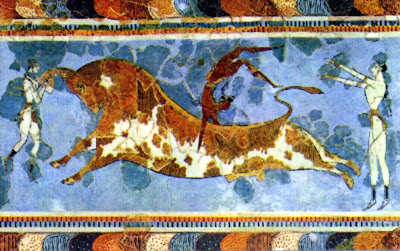Medici Sleeping Ariadne, National Archeological Museum, Florence
Karl Jaspers quotes Nietzsche to the effect that the sovereign mind is labyrinthine, "consumed little by little by the cave-dwelling Minotaur of his conscience," that the philosopher, like Theseus, has "a particular curiosity about the labyrinth" but that "whatever he may tell us, the labyrinthine man never seeks the truth but always only his Ariadne".. but.. "'Ariadne,' says Dionysis, 'You are a labyrinth. Theseus has become lost in you, he has no more thread.." Ariadne replies: "that is my last love to Theseus. I destroy him." Jaspers: "Ariadne for whom Dionysus becomes the labyrinth... Dionysus is the new truth when Theseus becomes 'absurd,' i.e. becomes a fanatic who seeks the truth at any cost. Nietzsche as Theseus is indeed lost in the labyrinth of Ariadne, but as Dionysus becomes the truth that transcends both death and life." After his mental collapse, Nietzsche was spied staging naked Dionysian dancing rites in his Turin room and wrote to Cosima Wagner "Ariadne, I love thee - Dionysus." In commenting on Nietzsche and the labyrinth, Deleuze identifies Ariadne and the thread as the anima, and in Jungian terms Nietzsche's syphilis prevents him from moving from the anima/soul-image phase to joining the earthy Magna Mater as the benign Old Wise Man, entering the Wise Man's dark megalomania as his brain mass deteriorates and he imagines himself Zarathustra and Dionysus, though I think if you're history's greatest philosopher you should be permitted to hug horses and dance, dance, dance.
Sleeping Ariadne, Vatican Museums
For Deleuze, the thread as the anima is solely "capable of reconciling us with the unconscious," while the labyrinth "leads us back to the same point.." to "designate the eternal return" for which "the labyrinth is becoming, the affirmation of becoming," which becomes for Ariadne a sort of affirmation by way of the thread. Deleuze identifies Dionysus as affirmation and Theseus ressentiment, a reactive force. "Dionysus developed, reflected (by Ariadne), raised to the highest power: these are the aspects of Dionysian willing which serves as principles for the eternal return."
Cornielle Van Cleve, Sleeping Ariadne, Versailles
In 1888, while Nietzsche was settling into Turin and getting started on Ecce Homo, Giorgio de Chirico was born in Volos, Greece to Italian parents. de Chirico would be six months old when Nietzsche broke down, at 18 reading Nietzsche for the first time, at 22 suffering from depression after his father's death, returning to Nietzsche and composing his first Metaphysical paintings, at 23 seeking out the apartment in Turin where Nietzsche stayed. "The novelty" of Nietzsche, he writes, "is a strange and profound poetry, infinitely mysterious and solitary, which is based on the Stimmung (I use this very effective German word which could be translated as atmosphere in the moral sense), the Stimmung.. of an autumn afternoon, when the sky is clear and the shadows are longer than in summer, for the sun is beginning to be lower... the Italian city par excellence where this extraordinary phenomenon appears is Turin." Schopenhauer wrote: "The inner Stimmung, the primacy of knowledge of the will, can produce this state in any given circumstance.. but this pure and objective Stimmung of the soul is encouraged and determined by encounters with external objects" similar in a way to Eliphas Levi's belief "the visible is the manifestation of the invisible" that influenced the French Symbolists.
When 24, de Chirico saw Cornielle Van Cleve's monumental replica of Ariane endorme at Versailles, based on the original in the Vatican Museum in the city where he had lived, inspiring an interest which would prompt the Guardian to reflect "never in art history has a painter been so obsessed with one subject." The Ariadne at the Met (above), having been abandoned by Theseus, is resting as a statue in the warmth of the sun. de Chirico was very proud of his father, an engineer, equestrian, and art aficionado who oversaw the construction of the first railways in Tuscany, and behind Ariadne is the moving train that recurs in his paintings as well as a phallic tower. This statue recurs in many of de Chirico's plazas, each time with the sun shining on her (1, 2, 3, 4), suggesting that he identified with the Ariane endorme as Nietzsche's anima and/or his own.
de Chirico's first metaphysical paintings of 1910, at 22, move stylistically from the brush stroke and compositional aspects of Arnold Böcklin, whom he had imitated, retaining certain aspects like, as in The Enigma of the Oracle (above), Böcklin's Odysseus in Odysseus and Calypso (right) becomes de Chirico's priestess Pythia looking down at Delphi, while Böcklin's white, central figure of Calypso becomes a statue of Apollo, partially obscured by a curtain. The early priests of Delphi were called Labyraden and frescoes of dolphins appear in the Palace of Knossos in Crete beside the labyrinth where the sea monster Apollo Delphinios was worshiped. Homer wrote of Apollo turning into a dolphin to transport Cretan priests to Delphi. Knossos also has a famous fresco of unexplained bull games:
de Chirico grew up in Athens, where he took his first painting lessons, and painted Greek antiquities all his life.





















